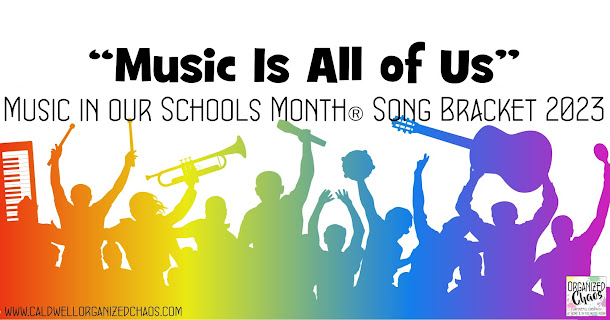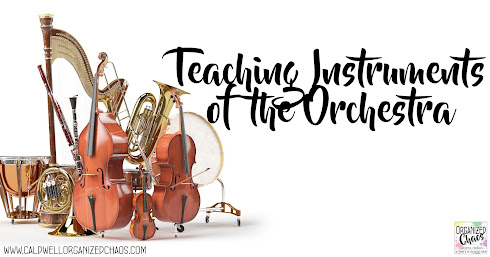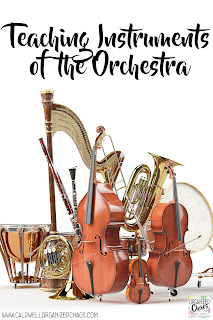Teaching the instruments of the orchestra is something that I think the vast majority of us include in our curriculum, but we don't talk about enough how to teach effectively. I think it's because it just seems pretty straight-forward, but the truth is just showing students pictures of instruments, telling them the names, and putting them in families isn't really effective by itself. Today I'm sharing how I scaffold and sequence my instruction across elementary grade levels to help my students understand instruments more holistically and retain the information they need over time.
1. Highlight specific instruments
The first step that I start in 1st grade (with a few things sprinkled into Kindergarten) is to pick a few specific instruments from different families and focus on exploring those and getting students familiar with what they look and sound like, and how they work. I have used (as I know many music teachers do) Peter and the Wolf for this and introduce students to the instruments that play each character's theme, but you could accomplish the same goal with any music that highlights individual instruments in a clear and engaging way.
2. Explore orchestral instrument families
In 2nd grade I focus on families of orchestral instruments. I use Britten's Young Person's Guide to the Orchestra, and we focus on the characteristics of each family, and identifying each family visually and aurally. We review the specific instruments they learned (as well as others they may know otherwise) and discuss the family in which they each belong.
I also discuss with my students at this point that these are just the Western orchestral instruments, and we talk about some of the other instruments they know beyond those categories, comparing and contrasting them with the orchestral instruments. They learn about instruments from around the world and from different genres beginning in Kindergarten so by 2nd grade they are very aware!
The other thing I have started pointing out to my students more recently is that there are different systems for categorizing instruments. I'm sticking with the brass/ percussion/ strings/ woodwinds groupings for my students mostly because I know that is language they are more likely to hear outside of my classroom, and especially because we use that language in our middle and high school programs, but I think it's important for them to know right from the beginning that this is not the "one and only" classification system, it's just one arbitrary one that is commonly used and is helpful for understanding how instruments work and sound.
3. Identify instruments visually
By 3rd grade students should be able to name at least 3-4 instruments in each of the 4 orchestral families, know what they look and sound like, and which family they are in. We review what they have learned so far about the orchestra as a whole, as well as specific instruments they have learned, and make sure everyone can identify at least 3 instruments from each family visually. I use specific examples from a wide variety of genres and musicians to explore each instrument individually, and we include the recorder as a woodwind instrument since they learn to play recorder in 3rd grade in my district.
One thing I have really focused on in recent years with these lessons is pushing back against common stereotypes with the examples I choose to share with my students. I could write a whole separate post on this topic alone, but it's important to note that this is a prime opportunity to introduce students to examples of these instruments being used in different contexts and played by different types of musicians beyond what people tend to think of as stereotypes of each instrument!
4. Identify instruments aurally
Obviously students have been listening to the instruments in every stage of this process already, but in 4th grade we focus on identifying instruments by sound. I have found this very helpful for helping students really grasp the concept of timbre and the influence that has on music as a whole, and it's one of those skills that can quickly become a cool "party trick" they can show off to their families :) I find this is also something that genuinely comes up more often than we might think in casual conversation as adults- someone is listening to some music and says, "what instrument is that? Is that a violin?".
5. Expanding beyond the orchestra
After 4th grade, we really start to focus on exploring, identifying, and classifying instruments outside the Western orchestra, from melodicas to cuicas and everything in between. As I mentioned already, students are learning about non-orchestral instruments and genres concurrently throughout the grade levels, but I really focus on merging those two concepts in 5th and 6th grade.
I hope this helps you think through how to sequence your instruction on instruments of the orchestra across grade levels. I haven't gotten into specific resources or lessons here because that would be too long! But all of my lesson plans and resources are included in my
K-6 general music curriculum, and I can share what I use for specific pieces of this if it's something you would like to see- please let me know if you're interested!













